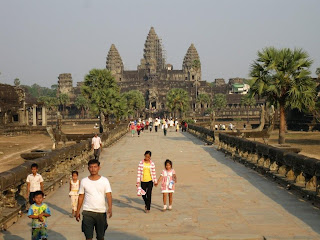This is war. This is a fight for survival. The movie Blood Diamond with Leonardo di Caprio springs to mind. He is repeatedly reminded in a South African accent “TIA: This is Erfrika”. TII. This is Eendia.
We are alive, but only just. Never, ever catch an overnight train in Eendia. Not only are the train stations infested with rats the size of cats, the carriages are full of their smaller cousins and snorting, snotting, farting, spluttering people. We were most unfortunate to share a 2 x 3 metre space with 4 locals, one of whom would, with frightening regularity, choke and cough blood, YES blood, in our direction. Nice. Would you believe that later in this post we mention getting sick?
Our 3 day, 2 night boat trip down the Ganges, Eendia's holiest river and the world's most polluted, began very pleasantly. The group split up among three small boats, with a kitchen boat in the rear, and we sailed, rowed and floated along some beautiful if slightly toxic and nutrient-rich waterways. (By the time you hit Varanasi the water is septic.) We camped on large sandbanks in the middle of the river. We sang songs on blankets in the sand. Riverfolk fished across the way. The boatmen were hard working. We were treated to buffet vegetarian meals on board the boat, in true Hindu spirit. How awesome is India, we thought? Our musings turned to pleasant TV ads rather than movies about death. In-cred-i-ble In-diyaaaaaaaaaaaaaa.


Matt was the first in the group to succumb, and really set the tone. On the second night he scrambled up the sandbank, staggered a short distance from the campsite and proceeded to spectacularly jettison ten litres of fluid in various ways and means over about 40 minutes. It was a kaleidoscope of colour and smell, and interspersed at times with him lying in a crater moaning. One particularly charming deposit even earned a tombstone of baked riverbed clay.


The holy cow is much revered, and causes traffic accidents frequently. No one dares touch the holy cow. Sadly for the holy cow, it suffers a life of street walking, pooing freely along the many Ghats (steps leading to the river where the locals bathe and wash their clothes) and masticating on garbage bags. The plastic bags cause the holy cow premature death by strangling its bowels.

Several Ghats are 'burning Ghats' reserved for cremation. The burning of bodies can be publicly viewed. The ashes are then thrown in the river. Interestingly, some people are exempt from being cremated, namely victims of leprosy and small pox, small children, pregnant women and holy men.
Two metres away at the neighbouring Ghats, locals frolic in the holy waters, bathing and washing, while the holy cows crap on the steps above.

Varanasi is renowned for its festivals. Every evening Hindus and gawking tourists gather on the main Ghat and watch the evening prayer light and sound spectacular, involving much chanting and candle waving.


dung drying .... (which also resolves a long-standing mystery about the McDonalds supply chain)

wedding processions and decorated vehicles ...

Ghat art ...

Cricket matches ...

and have enjoyed some local recreation - yoga. This is how it’s done.

This is not.

Next stop, stomach illness permitting, is the Taj Mahal.








 This morning we went on a guided walk to the city's largest mosque and, very interestingly, a Sikh temple.
This morning we went on a guided walk to the city's largest mosque and, very interestingly, a Sikh temple.


 We are now off on an overnight train into the wilderness, and then spening two and a half days on small (4-person) boats to float down the Ganges. We may head into the markets tonight to buy a sarong, which will be a DIY toilet screen on and off the boat. Wish us luck.
We are now off on an overnight train into the wilderness, and then spening two and a half days on small (4-person) boats to float down the Ganges. We may head into the markets tonight to buy a sarong, which will be a DIY toilet screen on and off the boat. Wish us luck.




























